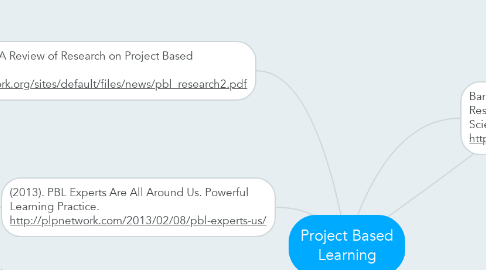Project Based Learning
by Allecia Kruser

1. Edutopia. Project Based Learning. http://www.edutopia.org/project-based-learning
1.1. Dewey, Aristotle, Confuscious, Plato
1.2. questioning and inquiry lead to deeper understanding, better remembrance of content
1.3. http://www.edutopia.org/blog/PBL-context-for-arts-integration-andrew-miller
1.3.1. great way to incorporate art across the disciplines
1.3.2. Arts can be used as assessment, scaffolding, performance, etc.
1.3.3. teaches valuable life skills - communication, collaboration, etc. - teaches student how to inquire, learn, and think critically
1.3.4. http://www.edutopia.org/project-based-learning-guide-importance - with todays technology - can interact with workers of the field, other administrators, etc to further engage students
2. 2010. An Introduction to Project Based Learning. https://www.youtube.com/watch?v=dFySmS9_y_0
2.1. many different activities as forms of assessment - allow each student to be successful
2.2. object learning - students create something to demonstrate what they have learned
2.3. students have opportunity to use information they are learning - motivates, seems relevant to them
3. (2013). PBL Experts Are All Around Us. Powerful Learning Practice. http://plpnetwork.com/2013/02/08/pbl-experts-us/
3.1. art teachers are excellent at facilitating PBL
3.2. PBL needs to have a balance of process, product, and reflection
3.3. conversing with experts in the field and becoming expert (through making art) are great ideas for PBL
4. Thomas, John. (2000). A Review of Research on Project Based Learning. http://w.newtechnetwork.org/sites/default/files/news/pbl_research2.pdf
4.1. PBL can be used to adapt to each individual students needs - create a custom plan for student success
5. Solomon, Gwen. (2003). Project Based Learning: A Primer. http://pennstate.swsd.wikispaces.net/file/view/pbl-primer-www_techlearning_com.pdf
5.1. with project based learning - the whole world becomes the classroom
5.2. PBL emphasizes lifelong learning in that students are using and gaining important skills that are always relevant - in many situations
5.3. allows students to use various technologies - ie spreadesheets, word processors, etc - allows several assessment types
6. (1995). Technology and Education Reform: Technical Research Report. http://www2.ed.gov/pubs/SER/Technology/ch8.html
6.1. changed role of student and teacher - students in real life situations - challenged - technology supports
6.2. use several different assessment types for well rounded, critical literacy education
7. School District Uses Project Based Learning over Tests. https://www.youtube.com/watch?v=waKZQ9gaBkI
7.1. schools often are teaching to the test - students are not remembering information or using life skills
7.2. single learning style not suitable for all
7.3. PBL school in US having huge success
8. Barron, Brigid. (1998). Doing With Understanding: Lessons From Research on Problem- and Project-Based Learning. Journal of Learning Sciences. http://www.tandfonline.com/doi/abs/10.1080/10508406.1998.9672056?journalCode=hlns20#.VIDMtotRnzI
8.1. PBL recognizes and encourages other learning styles
8.2. project based learning uses real life situations and problems in the classroom - student centered approach to learning - teaches students how to learn
8.3. Components of PBL include a guiding question, several forms of assessment, student choice, inquiry


